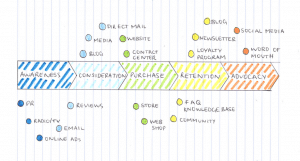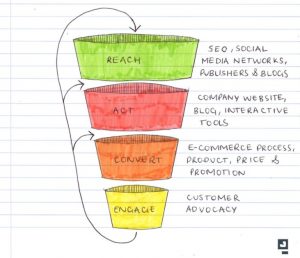What did we cover?
As the due date for our coursework was quickly approaching, this lesson was spent recapping on multi-channel campaigns and the models we have worked on throughout the units. We also looked at how exactly, we can in-corporate these into a digital marketing plan.
Customer Journey
To understand the customer journey, you must investigate the different touch points that your customer experiences with your company. I’m sure you are aware that customers don’t just make any purchase, from a company placing a product in front of them…
The customer journey is the pathway your customer takes from the first step of understanding the problem, to end goal of making a purchase from your company. Marketing channels are your customer, and brand touch-points. There are now so many different channels that can reach customers, and all customer journeys will be different for each brand depending on the platforms and channels your customer uses.
The marketing activities on the top demonstrate the actions made by the customer e.g. reading a blog, or visiting the company website, and the marketing activities along the bottom are actions made by the brand.
Multi-channel Campaigns
If executed correctly then multi-channel campaigns will increase your market reach for the same message, you would be extremely lucky if all of your audience were using the same platforms! In reality, they are most likely not, and this is why it’s important to use more than one channel to get your message across.
These campaigns also give you the ability to integrate with segmentation, as well as buyer personas. This integration means that when reporting you can look at campaigns as a whole, rather than analysing in sections. This will give you a much better idea of the success of a campaign.
Offline marketing activities can also be integrated and use the same messaging. However, this is slightly harder to report on and align with your online marketing activities.
Multi-channel campaigns will increase the overall strength of the message in your campaign and seeing more of the same message will reinforce it.
Marketing Funnel
The funnel outlines various stages that a prospect will follow, starting from the first point of contact such as a form completion on a website, to when the prospects makes a purchase. It’s a good way to visualise the customer journey and helps to demonstrate the funnel like process. Marketers should start broad and aim to capture as much leads as possible, then over time as you nurture prospects they should move down the funnel. Some prospects will drop out for reasons such as losing interest in your product, and as you get closer towards the end of the funnel you are left with the prospects who will turn into customers.
RACE Model
This model was introduced to aid online marketing activity planning, it integrates into the stages in the marketing funnel above.
REACH: [Buyer stage – Exploration] For raising awareness, this is usually done via social media platforms such as Facebook. Blogging and search engine optimisation is another way that companies can reach their customers.
ACT: [Buyer stage – Decision making] This is where the company is interacting with the customer through use of the website and they get closer to becoming a lead or customer. Blogging, content offers, and interactive tools are all ways that a company can act with customers for this stage.
CONVERT: [Buyer stage – Purchase] The contact has now become a valid customer and has completed a purchase.
ENGAGE: [Buyer stage – Advocacy] This is where companies should continue building the long-term relationship between them to encourage customers to become advocates. This will lead to a repeat sale or potentially recommendations to new customer who haven’t bought from you before.
SOSTAC
Planning… Where do you start? There’s a model for that! The SOSTAC model was created to help marketing planning, and it outlines a good methodical process to follow. The model helps guide you through all the necessary components of a marketing plan, it covers everything from identifying where you are now, getting where you want to be, and everything in between.
This is what SOSTAC stands for:
[S] Situation Analysis – Where are we now?
[O] Objectives – Where do we want to be?
[S] Strategy – How do we get there?
[T] Tactics – How exactly do we get there?
[A] Action – What is out plan?
[C] Control – Did we get there?
SITUATION ANALYSIS: At this point in the planning process you are trying to identify where you are now, you should consider using the SWOT tool here. Key areas to focus on in the situation analysis are marketing trends and themes, how well your competitors are performing, and your company’s internal resources and capabilities.
OBJECTIVES: The SOSTAC planning model uses the 5 S’s to help distinguish where we want to be:
Sell – Customer acquisition and retention targets
Serve – Customer satisfaction targets
Sizzle – Wow factor, this is the added value you offer
Speak – Engaging customers
Save – Quantified efficiency gains
STRATEGY: Moving on to working out how we actually get there, this stage in SOSTAC will give us an overview of our plan using the STOP & SIT tool:
Segments
Target markets
Objectives
Positioning (OVP)
And
Sequence (Trust, Try, Buy)
Integration (CRM & Database)
Targeting and Segmentation
TACTICS: You’ve done your overview of how you’re going to get there, now this stage goes into the specifics of how your strategy is going to work. The tactics of your marketing plan should talk about the 8 P’s of marketing, communications mix, content plan, and a contact plan.
ACTIONS: Who does what, and when do they do it? This stage assigns people with responsibilities, and tasks. It is also used to outline the processes and systems needed, internal resources and skills, and also if you require external resources they can be mentioned here.
CONTROL: Optimise! This section of the plan uses your KPI’s, objectives, and web analytics to optimise your activities. Through monitoring you can measure the success of user experience, conversion rate, frequency of reporting, and the process of how you report and carry out actions.
Why not visit Napier’s Toolbox if you’re interesting in producing your own tools for evaluation?


